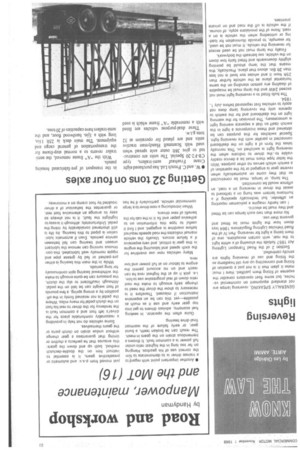Road and workshop
Page 35

If you've noticed an error in this article please click here to report it so we can fix it.
by Handyman
Manpower, maintenance
and the MoT (16)
• Another important point with regard to a trainee driver is to demonstrate to him the correct use of his gearbox. Hanging on far too long in the highest ratio under full power is a common fault. It throws a tremendous strain on the gears in mesh. The result can be broken teeth, a burst gear, or early failure of the rearmost final-drive bearing.
Quite often the operator, in seeking fuel economy, advises drivers to get into top gear early and use it as much as possible—yet this can be an expensive instruction if misused. Therefore it is necessary to show the driver the need to change early enough to make the next ratio down of real progressive use to him, i.e. pick it up at the highest revs he can reach and on no account permit the engine to labour on at full power and low revs.
Many vehicles now use overdrive for the sixth speed and labouring the engine in this gear is critical, and very expensive if a failure occurs. Usually the vehicle manual indicates the road speeds required before overdrive is engaged, and I find it useful to type this information on to adhesive paper and fix it in the cab for the benefit of new drivers.
When introducing a new driverto a large commercial vehicle, particularly if he has just moved from p.s.v. and automatic or preselective gears, it is essential to instruct him on the double-declutch method, both up and down the gears: this ensures that he perfects a rhythm or timing that guarantees a gear change without undue strain on clutch parts or the gears themselves.
Some vehicles do not help in providing a reasonably comfortable place for the driver's left foot and a common fault is the tendency for the driver to rest his foot on the clutch pedal for many miles. Where the pedal is not retained firmly in the offposition by a strong spring, a few pounds of foot weight can be laid on the pedal. Although insufficient to slip the clutch, the pressure can be quite enough to make the withdrawal bearing spin continuously for long periods.
While in the main this bearing is either pre-packed or fed by grease pipe and nipple normally well lubricated, this continuous running can remove the lubricant unseen and bearing can fail between service periods. Even if automatic lubrication is piped to this bearing, its life is still shortened considerably by riding the pedal. Unfortunately, although it is easy to highlight the fault, it is not always so easy to arrange an alternative foot rest, or guarantee the behaviour of a driver troubled by foot cramp on a motorway.




































































































